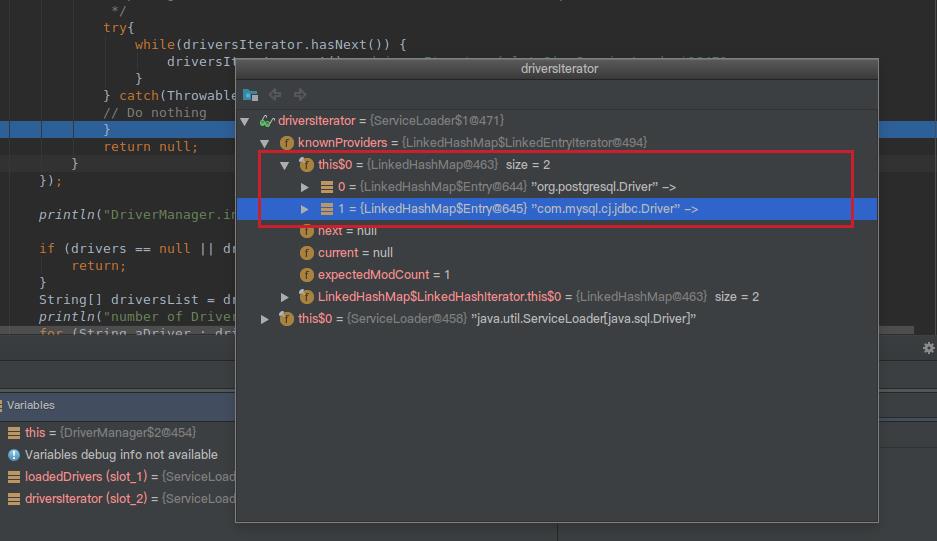javaSPI机制详解
Posted 九师兄
tags:
篇首语:本文由小常识网(cha138.com)小编为大家整理,主要介绍了javaSPI机制详解相关的知识,希望对你有一定的参考价值。

1.概述
以前的文章:【SPI】java基础之SPI框架实现
PI(Service Provider Interface),是JDK内置的一种 服务提供发现机制,可以用来启用框架扩展和替换组件,主要是被框架的开发人员使用,比如java.sql.Driver接口,其他不同厂商可以针对同一接口做出不同的实现,mysql和PostgreSQL都有不同的实现提供给用户,而Java的SPI机制可以为某个接口寻找服务实现。Java中SPI机制主要思想是将装配的控制权移到程序之外,在模块化设计中这个机制尤其重要,其核心思想就是 解耦。
SPI整体机制图如下:

当服务的提供者提供了一种接口的实现之后,需要在classpath下的META-INF/services/目录里创建一个以服务接口命名的文件,这个文件里的内容就是这个接口的具体的实现类。当其他的程序需要这个服务的时候,就可以通过查找这个jar包(一般都是以jar包做依赖)的META-INF/services/中的配置文件,配置文件中有接口的具体实现类名,可以根据这个类名进行加载实例化,就可以使用该服务了。JDK中查找服务的实现的工具类是:java.util.ServiceLoader。 ¶
2.SPI机制的广泛应用
2.1 SPI机制 - JDBC DriverManager
在JDBC4.0之前,我们开发有连接数据库的时候,通常会用Class.forName("com.mysql.jdbc.Driver")这句先加载数据库相关的驱动,然后再进行获取连接等的操作。而JDBC4.0之后不需要用Class.forName("com.mysql.jdbc.Driver")来加载驱动,直接获取连接就可以了,现在这种方式就是使用了Java的SPI扩展机制来实现。 ¶
JDBC接口定义
首先在java中定义了接口java.sql.Driver,并没有具体的实现,具体的实现都是由不同厂商来提供的。
mysql实现
在mysql的jar包mysql-connector-java-6.0.6.jar中,可以找到META-INF/services目录,该目录下会有一个名字为java.sql.Driver的文件,文件内容是com.mysql.cj.jdbc.Driver,这里面的内容就是针对Java中定义的接口的实现。 ¶
postgresql实现
同样在postgresql的jar包postgresql-42.0.0.jar中,也可以找到同样的配置文件,文件内容是org.postgresql.Driver,这是postgresql对Java的java.sql.Driver的实现。 ¶
使用方法
上面说了,现在使用SPI扩展来加载具体的驱动,我们在Java中写连接数据库的代码的时候,不需要再使用Class.forName(“com.mysql.jdbc.Driver”)来加载驱动了,而是直接使用如下代码:
tring url = "jdbc:xxxx://xxxx:xxxx/xxxx";
Connection conn = DriverManager.getConnection(url,username,password);
.....
这里并没有涉及到spi的使用,接着看下面的解析。
3. 源码实现
上面的使用方法,就是我们普通的连接数据库的代码,并没有涉及到SPI的东西,但是有一点我们可以确定的是,我们没有写有关具体驱动的硬编码Class.forName("com.mysql.jdbc.Driver")! 上面的代码可以直接获取数据库连接进行操作,但是跟SPI有啥关系呢?上面代码没有了加载驱动的代码,我们怎么去确定使用哪个数据库连接的驱动呢?这里就涉及到使用Java的SPI扩展机制来查找相关驱动的东西了,关于驱动的查找其实都在DriverManager中,DriverManager是Java中的实现,用来获取数据库连接,在DriverManager中有一个静态代码块如下:
static
loadInitialDrivers();
println("JDBC DriverManager initialized");
可以看到是加载实例化驱动的,接着看loadInitialDrivers方法:
private static void loadInitialDrivers()
String drivers;
try
drivers = AccessController.doPrivileged(new PrivilegedAction<String>()
public String run()
return System.getProperty("jdbc.drivers");
);
catch (Exception ex)
drivers = null;
AccessController.doPrivileged(new PrivilegedAction<Void>()
public Void run()
//使用SPI的ServiceLoader来加载接口的实现
ServiceLoader<Driver> loadedDrivers = ServiceLoader.load(Driver.class);
Iterator<Driver> driversIterator = loadedDrivers.iterator();
try
while(driversIterator.hasNext())
driversIterator.next();
catch(Throwable t)
// Do nothing
return null;
);
println("DriverManager.initialize: jdbc.drivers = " + drivers);
if (drivers == null || drivers.equals(""))
return;
String[] driversList = drivers.split(":");
println("number of Drivers:" + driversList.length);
for (String aDriver : driversList)
try
println("DriverManager.Initialize: loading " + aDriver);
Class.forName(aDriver, true,
ClassLoader.getSystemClassLoader());
catch (Exception ex)
println("DriverManager.Initialize: load failed: " + ex);
上面的代码主要步骤是:
- 从系统变量中获取有关驱动的定义。
- 使用SPI来获取驱动的实现。
- 遍历使用SPI获取到的具体实现,实例化各个实现类。
- 根据第一步获取到的驱动列表来实例化具体实现类。
我们主要关注2,3步,这两步是SPI的用法,首先看第二步,使用SPI来获取驱动的实现,对应的代码是:
ServiceLoader<Driver> loadedDrivers = ServiceLoader.load(Driver.class);
这里没有去META-INF/services目录下查找配置文件,也没有加载具体实现类,做的事情就是封装了我们的接口类型和类加载器,并初始化了一个迭代器。 接着看第三步,遍历使用SPI获取到的具体实现,实例化各个实现类,对应的代码如下:
//获取迭代器
Iterator<Driver> driversIterator = loadedDrivers.iterator();
//遍历所有的驱动实现
while(driversIterator.hasNext())
driversIterator.next();
在遍历的时候,首先调用driversIterator.hasNext()方法,这里会搜索classpath下以及jar包中所有的META-INF/services目录下的java.sql.Driver文件,并找到文件中的实现类的名字,此时并没有实例化具体的实现类(ServiceLoader具体的源码实现在下面)。 然后是调用driversIterator.next();方法,此时就会根据驱动名字具体实例化各个实现类了。现在驱动就被找到并实例化了。 可以看下截图,我在测试项目中添加了两个jar包,mysql-connector-java-6.0.6.jar和postgresql-42.0.0.0.jar,跟踪到DriverManager中之后:

可以看到此时迭代器中有两个驱动,mysql和postgresql的都被加载了。
4. SPI机制 - Common-Logging
common-logging(也称Jakarta Commons Logging,缩写 JCL)是常用的日志库门面,具体日志库相关可以看这篇。我们看下它是怎么解耦的。 首先,日志实例是通过LogFactory的getLog(String)方法创建的:
public static getLog(Class clazz) throws LogConfigurationException
return getFactory().getInstance(clazz);
LogFatory是一个抽象类,它负责加载具体的日志实现,分析其Factory getFactory()方法:
public static org.apache.commons.logging.LogFactory getFactory() throws LogConfigurationException
// Identify the class loader we will be using
ClassLoader contextClassLoader = getContextClassLoaderInternal();
if (contextClassLoader == null)
// This is an odd enough situation to report about. This
// output will be a nuisance on JDK1.1, as the system
// classloader is null in that environment.
if (isDiagnosticsEnabled())
logDiagnostic("Context classloader is null.");
// Return any previously registered factory for this class loader
org.apache.commons.logging.LogFactory factory = getCachedFactory(contextClassLoader);
if (factory != null)
return factory;
if (isDiagnosticsEnabled())
logDiagnostic(
"[LOOKUP] LogFactory implementation requested for the first time for context classloader " +
objectId(contextClassLoader));
logHierarchy("[LOOKUP] ", contextClassLoader);
// Load properties file.
//
// If the properties file exists, then its contents are used as
// "attributes" on the LogFactory implementation class. One particular
// property may also control which LogFactory concrete subclass is
// used, but only if other discovery mechanisms fail..
//
// As the properties file (if it exists) will be used one way or
// another in the end we may as well look for it first.
// classpath根目录下寻找commons-logging.properties
Properties props = getConfigurationFile(contextClassLoader, FACTORY_PROPERTIES);
// Determine whether we will be using the thread context class loader to
// load logging classes or not by checking the loaded properties file (if any).
// classpath根目录下commons-logging.properties是否配置use_tccl
ClassLoader baseClassLoader = contextClassLoader;
if (props != null)
String useTCCLStr = props.getProperty(TCCL_KEY);
if (useTCCLStr != null)
// The Boolean.valueOf(useTCCLStr).booleanValue() formulation
// is required for Java 1.2 compatibility.
if (Boolean.valueOf(useTCCLStr).booleanValue() == false)
// Don't use current context classloader when locating any
// LogFactory or Log classes, just use the class that loaded
// this abstract class. When this class is deployed in a shared
// classpath of a container, it means webapps cannot deploy their
// own logging implementations. It also means that it is up to the
// implementation whether to load library-specific config files
// from the TCCL or not.
baseClassLoader = thisClassLoader;
// 这里真正开始决定使用哪个factory
// 首先,尝试查找vm系统属性org.apache.commons.logging.LogFactory,其是否指定factory
// Determine which concrete LogFactory subclass to use.
// First, try a global system property
if (isDiagnosticsEnabled())
logDiagnostic("[LOOKUP] Looking for system property [" + FACTORY_PROPERTY +
"] to define the LogFactory subclass to use...");
try
String factoryClass = getSystemProperty(FACTORY_PROPERTY, null);
if (factoryClass != null)
if (isDiagnosticsEnabled())
logDiagnostic("[LOOKUP] Creating an instance of LogFactory class '" + factoryClass +
"' as specified by system property " + FACTORY_PROPERTY);
factory = newFactory(factoryClass, baseClassLoader, contextClassLoader);
else
if (isDiagnosticsEnabled())
logDiagnostic("[LOOKUP] No system property [" + FACTORY_PROPERTY + "] defined.");
catch (SecurityException e)
if (isDiagnosticsEnabled())
logDiagnostic("[LOOKUP] A security exception occurred while trying to create an" +
" instance of the custom factory class" + ": [" + trim(e.getMessage()) +
"]. Trying alternative implementations...");
// ignore
catch (RuntimeException e)
// This is not consistent with the behaviour when a bad LogFactory class is
// specified in a services file.
//
// One possible exception that can occur here is a ClassCastException when
// the specified class wasn't castable to this LogFactory type.
if (isDiagnosticsEnabled())
logDiagnostic("[LOOKUP] An exception occurred while trying to create an" +
" instance of the custom factory class" + ": [" +
trim(e.getMessage()) +
"] as specified by a system property.");
throw e;
// 第二,尝试使用java spi服务发现机制,载META-INF/services下寻找org.apache.commons.logging.LogFactory实现
// Second, try to find a service by using the JDK1.3 class
// discovery mechanism, which involves putting a file with the name
// of an interface class in the META-INF/services directory, where the
// contents of the file is a single line specifying a concrete class
// that implements the desired interface.
if (factory == null)
if (isDiagnosticsEnabled())
logDiagnostic("[LOOKUP] Looking for a resource file of name [" + SERVICE_ID +
"] to define the LogFactory subclass to use...");
try
// META-INF/services/org.apache.commons.logging.LogFactory, SERVICE_ID
final InputStream is = getResourceAsStream(contextClassLoader, SERVICE_ID);
if (is != null)
// This code is needed by EBCDIC and other strange systems.
// It's a fix for bugs reported in xerces
BufferedReader rd;
try
rd = new BufferedReader(new InputStreamReader(is, "UTF-8"));
catch (java.io.UnsupportedEncodingException e)
rd = new BufferedReader(new InputStreamReader(is));
String factoryClassName = rd.readLine();
rd.close();
if (factoryClassName != null && !"".equals(factoryClassName))
if (isDiagnosticsEnabled())
logDiagnostic("[LOOKUP] Creating an instance of LogFactory class " +
factoryClassName +
" as specified by file '" + SERVICE_ID +
"' which was present in the path of the context classloader.");
factory = newFactory(factoryClassName, baseClassLoader, contextClassLoader);
else
// is == null
if (isDiagnosticsEnabled())
logDiagnostic("[LOOKUP] No resource file with name '" + SERVICE_ID + "' found.");
catch (Exception ex)
// note: if the specified LogFactory class wasn't compatible with LogFactory
// for some reason, a ClassCastException will be caught here, and attempts will
// continue to find a compatible class.
if (isDiagnosticsEnabled())
logDiagnostic(
"[LOOKUP] A security exception occurred while trying to create an" +
" instance of the custom factory class" +
": [" + trim(ex.getMessage()) +
"]. Trying alternative implementations...");
// ignore
// 第三,尝试从classpath根目录下的commons-logging.properties中查找org.apache.commons.logging.LogFactory属性指定的factory
// Third try looking into the properties file read earlier (if found)
if (factory == null)
if (props != null)
if (isDiagnosticsEnabled())
logDiagnostic(
"[LOOKUP] Looking in properties file for entry with key '" + FACTORY_PROPERTY +
"' to define the LogFactory subclass to use...");
String factoryClass = props.getProperty(FACTORY_PROPERTY);
if (factoryClass != null)
if (isDiagnosticsEnabled())
logDiagnostic(
"[LOOKUP] Properties file specifies LogFactory subclass '" + factoryClass + "'");
factory = newFactory(factoryClass, baseClassLoader, contextClassLoader);
// TODO: think about whether we need to handle exceptions from newFactory
else
if (isDiagnosticsEnabled())
logDiagnostic("[LOOKUP] Properties file has no entry specifying LogFactory subclass.");
else
if (isDiagnosticsEnabled())
logDiagnostic("[LOOKUP] No properties file available to determine" + " LogFactory subclass from..");
// 最后,使用后备factory实现,org.apache.commons.logging.impl.LogFactoryImpl
// Fourth, try the fallback implementation class
if (factory == null)
if (isDiagnosticsEnabled())
logDiagnostic(
"[LOOKUP] Loading the default LogFactory implementation '" + FACTORY_DEFAULT +
"' via the same classloader that loaded this LogFactory" +
" class (ie not looking in the context classloader).");
// Note: unlike the above code which can try to load custom LogFactory
// implementations via the TCCL, we don't try to load the default LogFactory
// implementation via the context classloader because:
// * that can cause problems (see comments in newFactory method)
// * no-one should be customising the code of the default class
// Yes, we do give up the ability for the child to ship a newer
// version of the LogFactoryImpl class and have it used dynamically
// by an old LogFactory class in the parent, but that isn't
// necessarily a good idea anyway.
factory = newFactory(FACTORY_DEFAULT, thisClassLoader, contextClassLoader);
if (factory != null)
/**
* Always cache using context class loader.
*/
cacheFactory(contextClassLoader, factory);
if (props != null)
Enumeration names = props.propertyNames();
while (names.hasMoreElements())
String name = (String) names.nextElement();
String value = props.getProperty(name);
factory.setAttribute(name, value);
return factory;
可以看出,抽象类LogFactory加载具体实现的步骤如下:
- 从vm系统属性org.apache.commons.logging.LogFactory 使用SPI服务发现机制,发现org.apache.commons.logging.LogFactory的实现
- 查找classpath根目录commons-logging.properties的org.apache.commons.logging.LogFactory属性是否指定factory实现
- 使用默认factory实现,org.apache.commons.logging.impl.LogFactoryImpl
LogFactory的getLog()方法返回类型是org.apache.commons.logging.Log接口,提供了从trace到fatal方法。可以确定,如果日志实现提供者只要实现该接口,并且使用继承自org.apache.commons.logging.LogFactory的子类创建Log,必然可以构建一个松耦合的日志系统。 ¶
5. SPI机制 - 插件体系
其实最具spi思想的应该属于插件开发,我们项目中也用到的这种思想,后面再说,这里具体说一下eclipse的插件思想。
Eclipse使用OSGi作为插件系统的基础,动态添加新插件和停止现有插件,以动态的方式管理组件生命周期。 一般来说,插件的文件结构必须在指定目录下包含以下三个文件:
META-INF/MANIFEST.MF: 项目基本配置信息,版本、名称、启动器等
build.properties: 项目的编译配置信息,包括,源代码路径、输出路径
plugin.xml:插件的操作配置信息,包含弹出菜单及点击菜单后对应的操作执行类等
当eclipse启动时,会遍历plugins文件夹中的目录,扫描每个插件的清单文件MANIFEST.MF,并建立一个内部模型来记录它所找到的每个插件的信息,就实现了动态添加新的插件。
这也意味着是eclipse制定了一系列的规则,像是文件结构、类型、参数等。插件开发者遵循这些规则去开发自己的插件,eclipse并不需要知道插件具体是怎样开发的,只需要在启动的时候根据配置文件解析、加载到系统里就好了,是spi思想的一种体现。 ¶
6.SPI机制 - Spring中SPI机制
在springboot的自动装配过程中,最终会加载META-INF/spring.factories文件,而加载的过程是由SpringFactoriesLoader加载的。从CLASSPATH下的每个Jar包中搜寻所有META-INF/spring.factories配置文件,然后将解析properties文件,找到指定名称的配置后返回。需要注意的是,其实这里不仅仅是会去ClassPath路径下查找,会扫描所有路径下的Jar包,只不过这个文件只会在Classpath下的jar包中。
public static final String FACTORIES_RESOURCE_LOCATION = "META-INF/spring.factories";
// spring.factories文件的格式为:key=value1,value2,value3
// 从所有的jar包中找到META-INF/spring.factories文件
// 然后从文件中解析出key=factoryClass类名称的所有value值
public static List<String> loadFactoryNames(Class<?> factoryClass, ClassLoader classLoader)
String factoryClassName = factoryClass.getName();
// 取得资源文件的URL
Enumeration以上是关于javaSPI机制详解的主要内容,如果未能解决你的问题,请参考以下文章